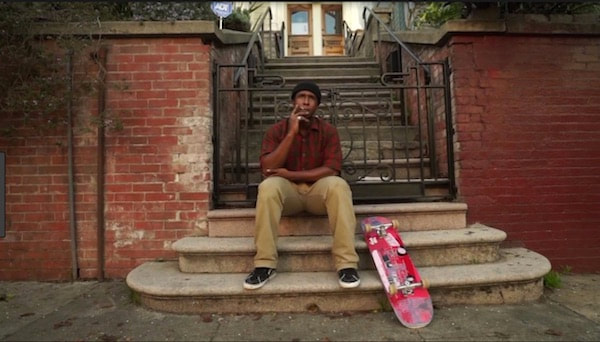|
What the film "The Last Black Man in San Francisco" lacks in writing and actually story and character development, it makes up for in look and feel. Well, not really because, sadly, its shortcomings are what is noticed early into the movie, and the last thing you remember as you walk out the theater. The film, directed and co-written by Joe Talbot, centers around a twenty-something-year-old Black lead character, Jimmy Fails, played by actor Jimmy Fails, who yearns to move back into his childhood house, a once grand Victorian in a historic neighborhood of San Francisco. Sadly, he and his family have long been displaced from the house and hood, replaced by more affluent white people who for some unexplained reason never manage to maintain the house or yard. While Jimmy’s father is apparently in a sort of group home or low income housing complex in a seedy part of the City, his aunt resides way out in another, more rural part of the Bay Area, Jimmy crashes with his friend, Jonathan (Montgomery Allen), a wanna-be artist and writer, and his friend’s blind father (Danny Glover) in the East Bay. Several dudes from the hood are permanent fixtures on Jonathan’s street, arguing, rapping and taunting Jimmy and Jonathan whenever they walk by. To the two of them, the group is an anomaly. They are too busy watching their movements and perplexed by their speech to really notice the insults they are constantly hurly their way. It’s as if they want to be like them or be apart of their clique, dysfunctional as it may be. Instinctively, they know with their sensitive, quiet, artistic demeanor, they would never be accepted or understood by the group. So instead, they quietly walk by them, looking and usually avoiding confrontations.
As close as Jimmy is to Jonathan, and as much as he appreciates a place to sleep, Jimmy is overwhelmed with nostalgia for what he considers his house, its history, and the city. He doesn’t want to live any place else. It is that obsession that drives Jimmy to regularly stop by there while the owners are out, peering into the windows, sweeping the steps or painting the trim while Jonathan is on the lookout for the couple that could return any minute. And they often do, with a vengeance. The wife is constantly furious with Jimmy, insisting he get off their property and threatening to call the police, while the husband is more compassionate, imploring for her to calm down. Eventually, the couple lose the house themselves due to family issues, vacating while things are in litigation. Jimmy seizes the opportunity to break in and squat until he can figure out a way to raise money to purchase it. A prospect doomed to failure given he barely works and is obviously financially strapped. If only principal, passion and persistence paved the way to ownership in America. In an effort to help Jimmy, Jonathan gleans information from a real estate agent who seemingly befriended them earlier, a slick yuppie character who is only loyal to his next big score. The information Jonathan retrieves is less about the logistics of possibly acquiring the house, and more about the true history of its ownership and Jimmy’s family. Therin lies the twist. The movie implies that it’s about gentrification and racism, and it does touch on those themes, but it’s really more about a sad, neglected and technically homeless young man who is stuck in the past concerning his family and understandably frustrated with the transformation of his hometown. Jimmy is the best neighbor anyone could have in any city, but he is without house, home and city. His plight represents that of millions of others, but it sadly is not truly explored. I wanted this to have a stronger defined theme of gentrification and its impact on the usual minority victims of it. San Francisco, like New York, is the epitome of a city that has become accessible only to the rich. It once thrived in ethnic and economic diversity, now it is overwhelmingly home to the rich, young and white, thanks in large part to the tech industry. While Jimmy and Jonathan are affable characters and they are lovingly and effectively portrayed by two impressive actors worthy of notice, the story from a writing perspective is undeniably lacking. It’s a movie giving the appearance of something special and begging to be more, but falling short. The pacing is achingly slow, without purpose, and the length is too long for its shortcomings. That being said, it is a respectable debut feature film project for director, Talbot who is a longtime friend of and collaborator with Falis. The standout aspect of the film is its look. If you only see the film for its cinematography, that would be understandable, encouraged, and you would not be disappointed. With stunningly gorgeous shots, Adam Newport-Berra greatly elevates what would otherwise be a mediocre movie.
0 Comments
Leave a Reply. |
AuthorPaula Farmer. Archives
June 2024
Film |

 RSS Feed
RSS Feed